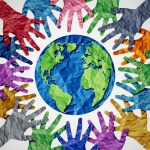This week, in my discussion on civil discourse, I want to demonstrate how we can talk about how we can understand and support the LGBTQIA+ community in a compassionate, Christ centered manner. As a word of disclaimer, this is not my wheelhouse. What follows is not meant to speak for a community of God’s people I will never fully understand. This is my attempt as a healer and a pastor who cares deeply for all of God’s creation to bridge a gap and reach out a loving hand in the name of Christ, a gesture seldom often seen. My intended audience this week are those in the Christian church who are continuing to struggle to be Christ’s presence with all of God’s kindom. Check out my other article around this topic.
Learning How to be an Ally to the LGBTQIA+ Community
Two moments in my formative young life stand out that changed my perspective on the LGBTQIA+ community. One was in college, a mentor of mine chastised me for considering members of this community could be loved by God. The second incident was when I went to seminary (they say seminary will ruin your faith, it was true). I met a wonderful woman named Gale who had been with her partner for a long time and was a minister of a church in church in the city near where I was in school. This woman’s devotion to her partner rivaled the devotion I had to my newly married wife. Her faith made mine seem insignificant.
When communicating with, “about, or for LGBTQIA+ (lesbian, gay, bisexual, transgender, queer and/or questioning, intersex, and other) communities, it is important to consider the unique needs and barriers these populations encounter. Compared to cisgender and heterosexual people, LGBTQIA+ people experience higher rates of discrimination, stigma, and rejection because of their gender identity and sexual orientation. This may affect employment, housing, access to health care, and more. Understanding the history of prejudice and trauma will help to ensure that your communication efforts are respectful, inclusive, and supportive.”
Dispelling the Myth – An Exploration in First Century Sexuality
Christians are notorious for their use of the “clobber verses” in their defense of the Christian faith and to other people. One of the first things we need to understand about the bible is that it is an anthology of stories, wisdom literature, poetry and commentary about a people who lived a long time ago. These stories were not written with our modern mindset in mind. What was culturally appropriate during the biblical times may not have aged well.
The other problem is interpretation. We can make the scriptures say anything we want it to say to fit our ego driven perspective. Too often, we let our ego desire drive how we interpret the scripture rather than understanding it through the specific lens Jesus and later his followers used to understand their world.
Unfortunately, the scriptures do say some pretty damming things about homosexuality. First century Palestinian Jews would have found homosexuality incompatible with their Judaism at the time. The subject of homosexuality and Judaism dates back to the Torah. The book of Vayikra is traditionally regarded as classifying sexual intercourse between males as a to’eivah that can be subject to capital punishment by the Sanhedrin under halakha. Modern Jewish denominations have continued to struggle with this leading to debate and division.
Reformed Jews today get around some of these biblical prohibitions by “employing the research that points to the involuntary nature of homosexuality. The halakhic (legal) term ahnoos refers to someone who, though commanded to do something, does not really have a choice in the matter. In Judaism, one is only responsible for religious obligations that one can freely choose to fulfill. Thus, some Jewish authorities have argued that since homosexuality is not chosen, its expression cannot be forbidden”.
At the end of it all, Jesus was a Jewish male who was a cultural revolutionary, who I feel would have sided with the Reformed Jews of today. Jesus embraced “those who were shunned by the religious elite—those who did not conform to Jewish or biblical standards.” For us to practice the religion of Jesus means engaging in the same radical love and inclusiveness Jesus would have demonstrated.
Important Points to Consider when Having a Productive Conversation around LGBTQIA+
Having a productive conversation about the LGBTQIA+ community requires a foundation of respect and understanding. In the article referenced in the opening section, the authors ask us to consider “though LGBTQI+ is an acronym used to collectively describe non-heterosexual and non-cisgender identities, the terms “sexual and gender minority (SGM)” and “sexual and gender diverse (SGD)” are more commonly used in the context of health research. SGM and SGD are inclusive, umbrella terms to describe LGBTQI+ populations”. I have never been exposed to this language in any of my professional development work. I feel though this language closes some gaps I have seen with some of my LGBTQIA+ clients over the years. What they have helped me understand from their perspective is that for them, it is not as much of a binary (you are either one of these letters, LGBTQIA+) as it is a spectrum. It is felt then that this proposed language from the National Institiute of Health is appropriate.
The NIH article referenced throughout this discussion also offers these changes in our language, all of which I have observed in my professional work:
- Affirmed gender, not preferred gender or chosen gender or lifestyle
- Transgender, not transgendered, transgenderism, transsexual, or transvestite
- Transition or transitioning, not transgendering, sex change, or sex reassignment surgery
Here are other some key points to keep in mind:
Acknowledge Diverse Identities:
The LGBTQIA+ community encompasses a wide range of sexual orientations and gender identities. It’s crucial to recognize this diversity and avoid generalizations.
Focus on Shared Humanity:
Emphasize the common ground we all share as human beings. Respect for basic human rights and dignity should be non-negotiable.
Listen with Empathy:
Be willing to genuinely listen to the experiences and perspectives of LGBTQIA+ individuals. Try to understand their concerns, challenges, and joys.
Challenge Stereotypes:
Be mindful of harmful stereotypes and assumptions. Avoid perpetuating misinformation or discriminatory language.
Find Common Ground:
Look for areas of agreement and shared values. This can help build bridges and foster understanding.
Respect Disagreement:
It’s okay to have different viewpoints. However, it’s important to express those differences respectfully and avoid personal attacks.
Educate Yourself:
Continuously seek to learn more about LGBTQIA+ issues and experiences. This can help broaden your understanding and challenge your own biases.
Remember, civil discourse is about having respectful and meaningful conversations, even when we disagree. By following these guidelines, we can create a more inclusive and understanding society for everyone. The Christ presence dwells in all of us. We are all made in the image of God. Our egos do not get to dictate what that image looks like. Our cultures do not get to dictate what that image looks like. All are included in God’s kindom. Jesus is clear, we must love.













